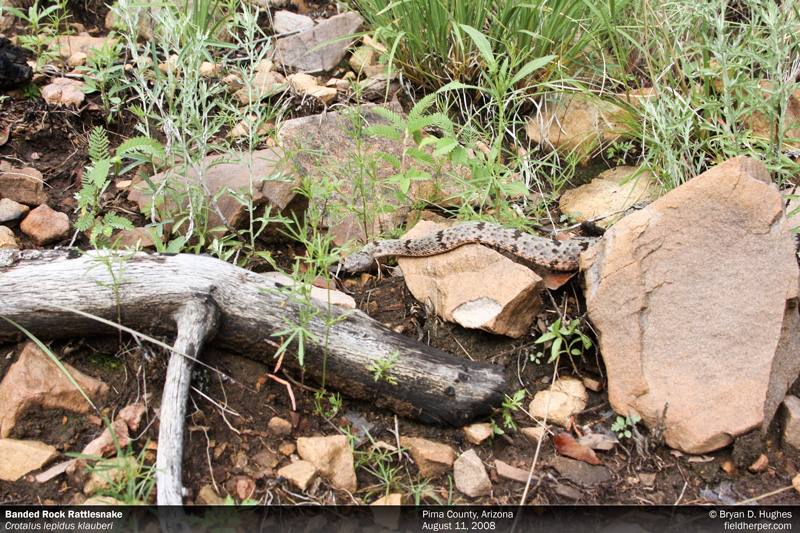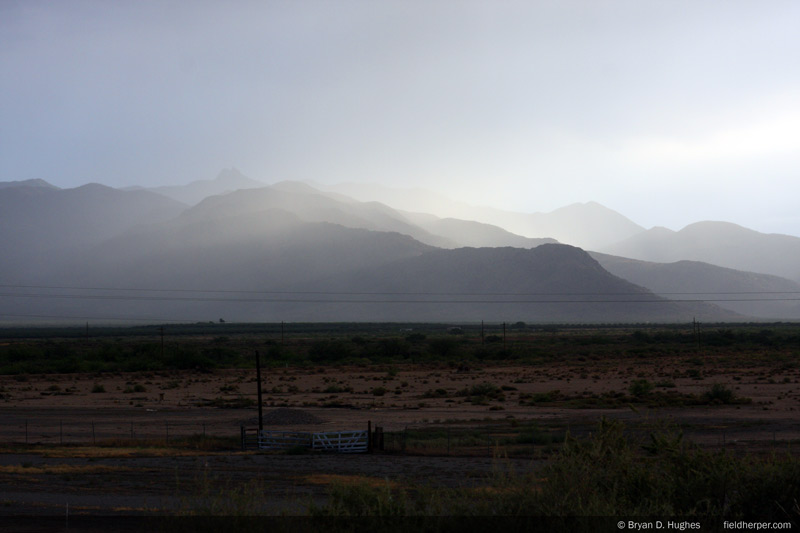Kelly and I went for a hike through the low areas of the Harcuvar mountains in Eastern La Paz County today, looking for snakes of course, but mostly just getting a bit of a workout in preparation for the upcoming year. Other than some amazing habitat, the only snake we found was an adult Desert Patch-Nosed Snake, Salvadora hexalepis hexalepis, layed out basking in the sun. I would have been content leaving him to his nap, but this was Kelly’s first experience with this animal and I wanted to make sure she got a close look.

Desert Patch-Nosed Snake. Not very friendly.

As he was found, laying out in a wash.
Tags: colubrid, field herping arizona, harcuvar, patch-nose, patch-nosed, patchnose, patchnosed, salvadora hex, snake
Posted in Field Herping | No Comments »
Here’s a Lowland Leopard Frog (Rana yavapaiensis) from Santa Cruz County. I’ve seen this species before, but did not realize that it was not the very similar-looking Chiricuahua Leopard Frog until I had returned home and found my half-ass photos weren’t good enough to salvage … not that this one is spectacular or anything. I like frogs.

Lowland Leopard Frog
Here’s some habitat in the area. This is typical for this part of Santa Cruz County. People that visit for the first time are usually very surprised by how green and lush it is 3-4 miles from the Mexican border.

Santa Cruz County
Get email updates!
Tags: Field Herping, herper, herping, herping se az, lowland leopard frog, Rana yavapaiensis, santa cruz county, south east arizona
Posted in Field Herping | No Comments »
This is a both a completely horrible photo, and an example of why I love the camera RAW format. I did not check my exposure settings before taking pictures of this guy, and ended up with a card of pure-black trash. This is not an ideal photo of course, but I was able to salvage this from seemingly nothing. Fancy stuff.
Anyway, this is a California Kingsnake (Lampropeltis getula californiae) from North of Wickenberg. I’ve never seen one out in the daylight hours before, and this one was big, fat, and quite aggressive.
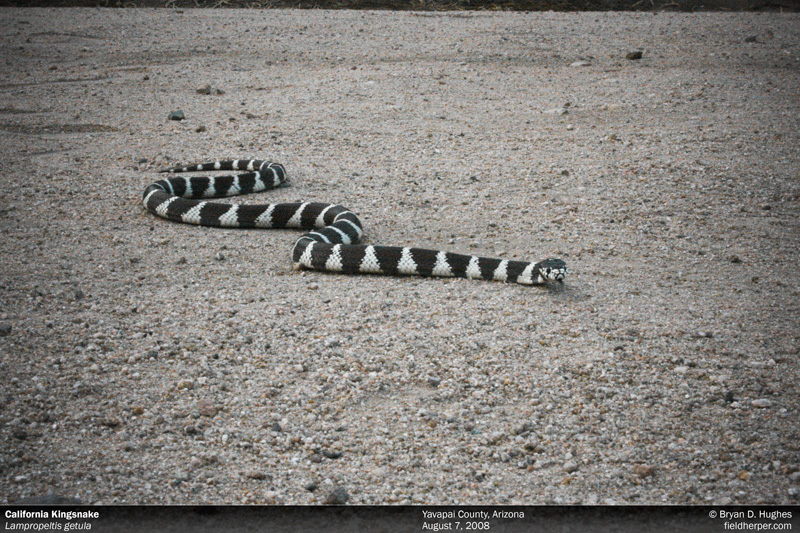
California kingsnake
Tags: california kingsnake, californiae, Field Herping, getula, king snake, lampropeltis, Photography, RAW
Posted in Equipment, Field Herping, Photography | No Comments »
Spring is here, and I’m finally out hiking several times a week. I haven’t seen many snakes yet, but these side-blotched lizards are everywhere. They let you get decently close before running away, and can display some brilliant colors this time of year. I usually don’t take many photos of them, but this one stayed on his rock and tried to scare me off with some terrifying head-bobs, so at least deserves documentation.

Common Side-Blotched Lizard north of Anthem, Arizona
Tags: lizard, side-blotched lizard
Posted in Field Herping | No Comments »
Here’s another shot of a Ridge Nosed Rattlesnake (Crotalus willardi) we found last August. Cool little snakes, and very enjoyable to search for.

Crotalus willardi in South East Arizona
Tags: crotalus willardi, field herpetology, Field Herping, herping arizona, ridge nose, ridgenose rattlesnake, ridgenosed rattle snake, sky islands
Posted in Field Herping, Photography | No Comments »
I’ve recently been getting out a bit into the hills immediately North of my new home of Anthem, Arizona, and recording coordinates of good places to check for snakes later in the year. Other than some Chuckwallas and signs of snake activity, I haven’t found much. As always, when snakes are scarce, sunset photos fill my card. I’m having a great time with the HDR technique and learning more about my camera. Fun stuff.

North of Anthem Arizona
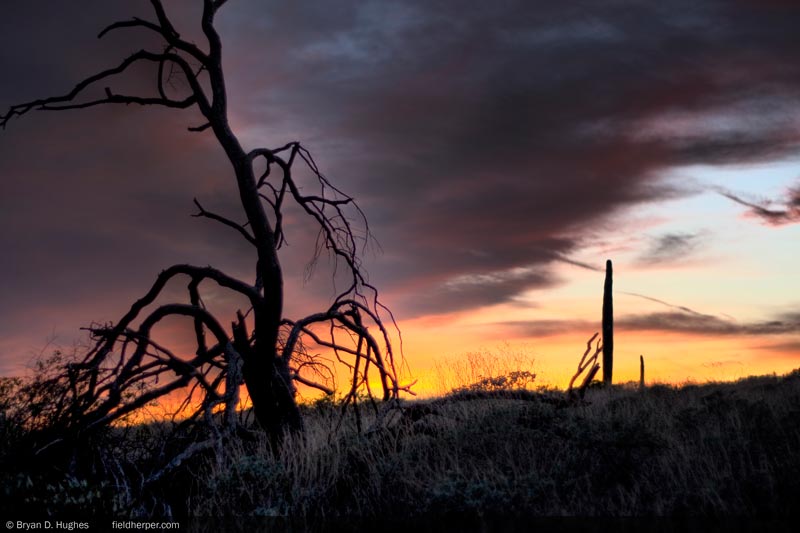
More HDR Shit
Tags: anthem, arizona, Field Herping, HDR Photography, landscape, scenery
Posted in Landscapes, Photography | No Comments »
I’ve had a few conversations in the last year (most recently, yesterday) about the size differences in Crotalus atrox and other species of rattlesnake. In Arizona, the largest rattlesnake I’ve seen was maybe a few inches past 4′ in length, with the majority of encountered adults being just over 3′. I’ve found 4 instances of atrox in New Mexico; the largest, in the South Eastern part of the sate, was perhaps a small bit larger than the biggest one I’ve found in Arizona. The same species 2 states away in Texas get much larger, with an average of 4.5-5′, and a record size of 6′ 8″.
Thoughts on the subject from fellow herpers usually assume food availability and competition is a primary factor in our mini-atrox. I was doing some reading today on the topic and found found some information on supplemented food effecting growth rates (and other factors) in atrox. Although it does not infer discuss food availability in Texas versus Arizona, it does show that this is a factor that can directly result in larger or smaller animals. Interesting reading for anyone interested in the subject.
Effects of food supplementation on Western diamond-backed rattlesnakes Crotalus atrox in the Upland Sonoran Desert, Arizona, USA
Taylor E.N, Malawy M.A., Browning D.M., Lemar S.V. & DeNardo D.F. (2005) Effects of food supplementation on the physiological ecology of female Western diamond-backed rattlesnakes (Crotalus atrox). Oecologia, 144, 206-213 (added by: Showler D.A. 2006).
Tags: arizona, biggest rattlesnake, Crotalus atrox, Diamond back, Diamondback, herpetology, largest rattlesnake, rattlesnake, texas diamondback, texas rattlesnakes
Posted in Research | No Comments »
It’s been on the warm side lately; being the end of February, we’ll have 90F daytime temperatures in a couple of weeks. The snakes are waking up, and they’re hungry and want to meet some girls. Although it didn’t quite hit 80 degrees here in Anthem today, I had tons of energy to burn off and thought I’d go for a little sunset hike in an area north of my new home I have yet to really explore.
Here’s a fancy pants HDR picture from my new lens:
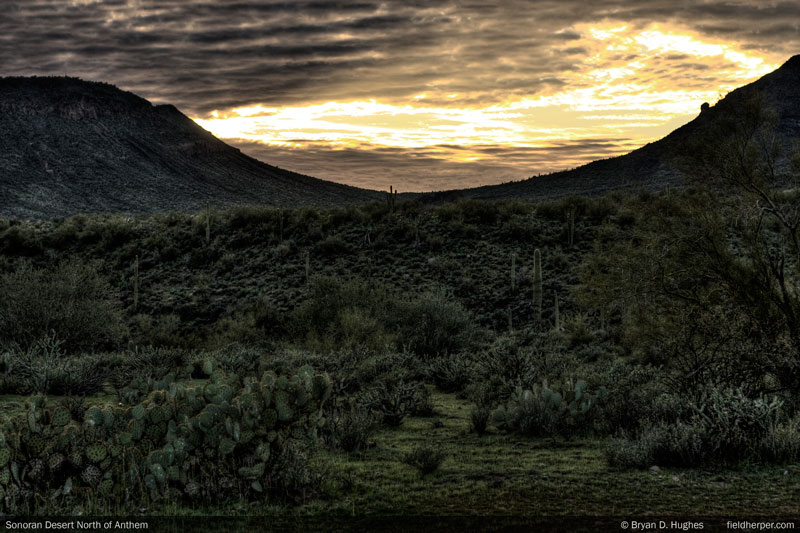
Desert North of Phoenix
I hiked around awhile and found some cool places with a lot of flat, chipped rock that looks to be good on an afternoon sometime. On the way home, look who I found out cruising around:
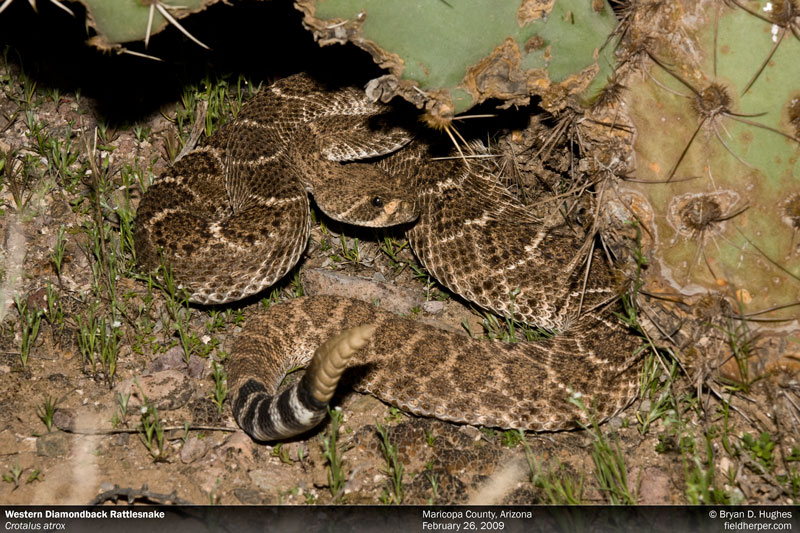
Crotalus atrox
It’s the second Western Diamondback Rattlesnake (Crotalus atrox) I’ve seen this year. Something that’s immediately apparent in the two instances of atrox I’ve seen up here in the Anthem area that is different than the Mesa variety I’ve seen the most in the past is the higher amount of pink coloration; especially in the face. I look forward to seeing what other variations might be present in some of the common locals.
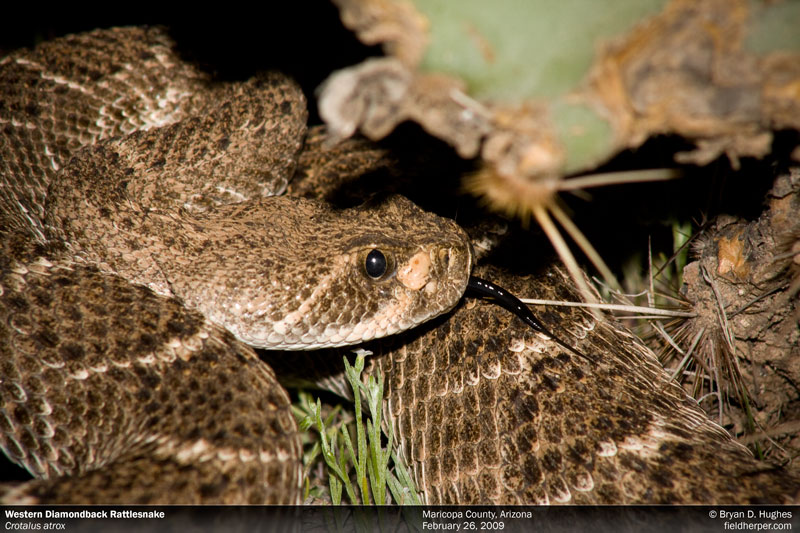
Crotalus atrox
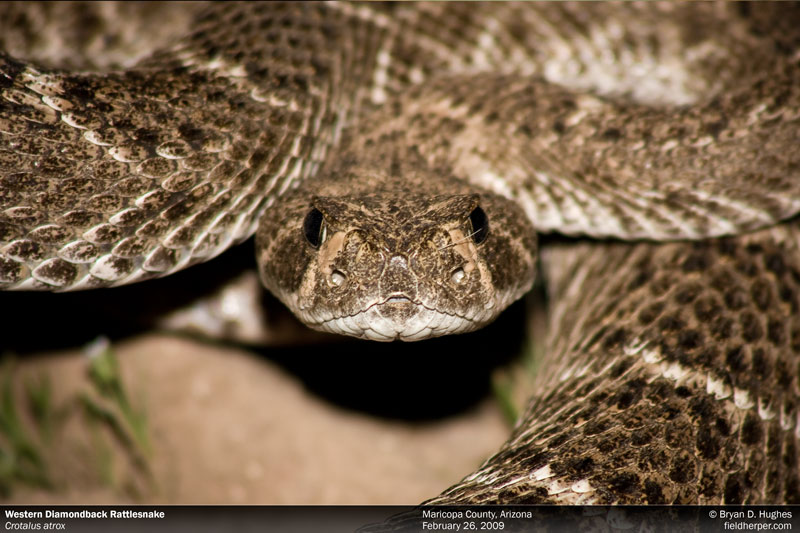
Crotalus atrox
Tags: anthem arizona, bryan d. hughes, Crotalus atrox, Diamondback, Field Herping, HDR Photography, phoenix, rattlesnakes, Western Diamondback Rattlesnake
Posted in Field Herping, Landscapes | 1 Comment »
After hiking many miles last Sunday and finding no snakes, I was happy to get my first relocation call of 2009. Nothing crazy or all that exciting, but I still went nuts trying to find all my gear; still hidden in various parts of the garage after our move.
He was under a pile of rocks in the homeowner’s back yard and came out all pissy, as a good rattlesnake should. He now lives in a rocky drainage area on the hill overlooking the neighborhood.
This is also the earliest in the year I’ve seen a snake out and about. Slick.
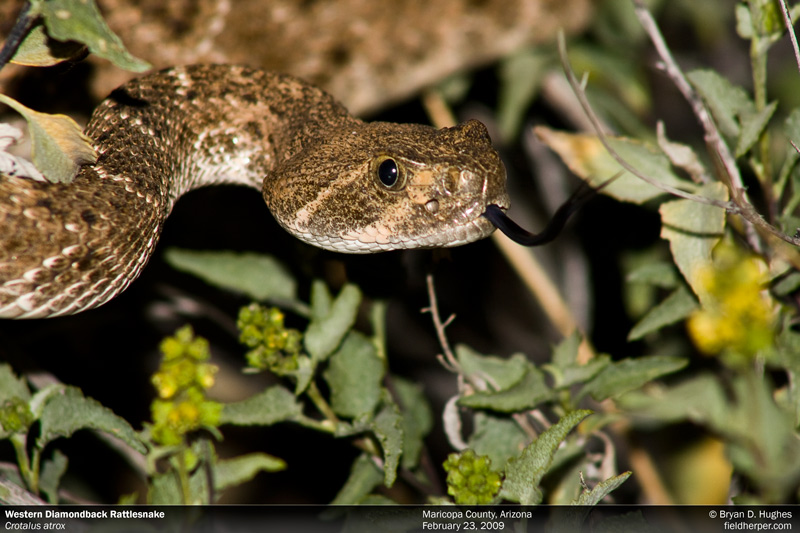
Crotalus atrox near Carefree Rd. in Phoenix

Western Diamondback Rattlesnake in Arizona

Let me out!
Tags: Crotalus atrox, Diamondback, phoenix arizona, rattle snake, rattlesnake, rattlesnake relocation, western diamondback
Posted in Relocation & Rescue | 1 Comment »
Kelly and I visited Oahu, Hawaii this January. To the surprise of most, there are no native reptiles or amphibians in Hawaii. There are, however, 17 invasive species that have done very well for themselves. These include the Jackson’s Chameleon, which would be very cool to see, but upon doing some research … it’s not worth it. They life in disturbed secondary forest, which is the technical term for “backyard” or “shrubs behind the Burger King”. I’d like to see one of course, but that’s not why I herp. To me, seeing an invasive species crawl around someone’s landscaping is not any different than seeing one in a pet store. Let’s go back to the beach.
We did see a couple species of gecko, and brown anoles were everywhere in town. The pictures aren’t the best, as my preferred lens for these type of shots was killed by a wave while I was taking pictures of a crab. Whoops.

Brown Anole

Mourning Gecko
Tags: Anolis sagrei, Brown Anole, Hawaii, Lepidodactylus lugubris, Mourning Gecko, Oahu, Reptiles of Hawaii
Posted in Field Herping, Field Trips, Personal, Photography | No Comments »




